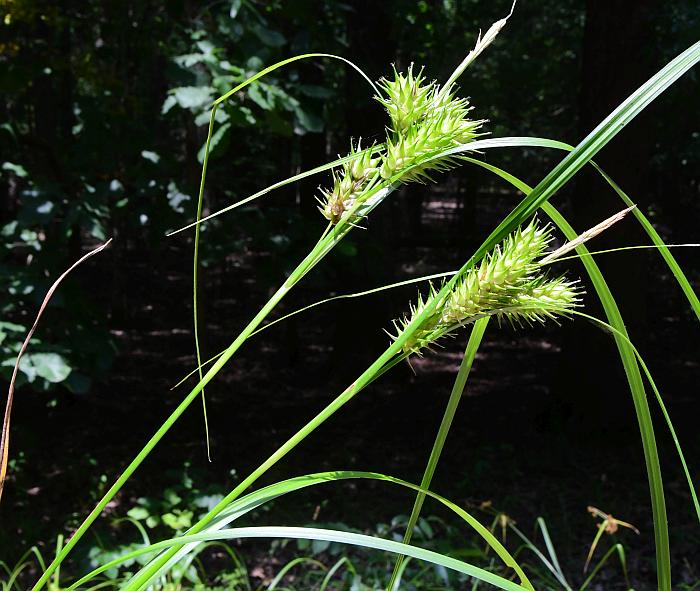Carex lupulina Muhl. ex Willd.
Hop Sedge

Native
CC = 6
CW = -5
MOC = 80
© SRTurner
Carex lupulina Muhl. ex Willd.Hop Sedge | |
 |
Native CC = 6 CW = -5 MOC = 80 |
© SRTurner |
|
Family - Cyperaceae Habit - Monoecious sedge, often with long-creeping, dark brown rhizomes, forming clumps or scattered tufts.
Stems - Vegetative stems generally poorly developed or absent. Flowering stems 1 to few per tuft, to 1.3 m, smooth, light brown to somewhat reddish tinged at the base. Leaves - Leaf blades 15-65 cm long, 4-15 mm wide, dull green. Leaf sheaths slightly prolonged past the insertion point of the blade, truncate or slightly convex at the tip, the ligule longer than wide and V-shaped, the uppermost leaf (not a bract subtending a spike) with the sheath 1.5-25.0 cm long.
Inflorescence - Terminal spike staminate, the 1-5 lateral spikes pistillate.
Spikes - Staminate spike 15-85 mm long, 1-5 mm wide, nearly sessile to long-stalked, but the stalk shorter than to about as long as the uppermost pistillate spike. Staminate scales 7-15 mm long, narrowly oblanceolate to lanceolate, tapered to a pointed or awned tip, straw-colored with a green midrib and white margins. Pistillate spikes 1-5, 15-65 mm long, 13-30 mm wide, ascending, ovate to broadly elliptic in outline, with 8-80 perigynia. Pistillate scales 6-15 mm long, lanceolate to narrowly ovate, tapered to a pointed or rough-awned tip, straw-colored with a green midrib and white margins.
Perigynia - Perigynia 11-19 mm long, mostly ascending, narrowly ovate in outline, green or sometimes yellowish brown at maturity, somewhat shiny, glabrous, the tip with the beak 6-10 mm long, the base rounded. Styles strongly contorted near the base. Fruits with the main body 3.0-4.0 mm long, longer than wide, diamond-shaped in outline, widest at the middle, the angles narrowly rounded, the sides flat or nearly so.
Flowering - May - September. Habitat - Swamps, bottomland forests, marshes, sloughs, bottomland prairies, wet prairie swales, streambanks, pond margins, ditches; sometimes emergent aquatics. Origin - Native to the U.S. Lookalikes - Carex lupuliniformis (relatively uncommon in Missouri), other species within Carex section Lupulinae, and to a lesser extent species within section Squarrosae. Other info. - This charismatic sedge is fairly common throughout Missouri and the eastern half of the continental U.S. Its range ends at a well-defined vertical line which runs roughly along Missouri's western border. It is one of the easier sedges to identify when in fertile condition, having very large spikes with large, long-tapered perigynia. The perigynia are, in fact, some of the largest of any of Missouri's sedges. The plant is closely related to the well-known globe or "Sputnik" sedge (C. grayi), and somewhat resembles that species except the spikes are elongate rather than spherical. The fruits are oval shaped and not knobby, and the persistent styles are strongly contorted near the base. Photographs taken at Otter Slough Conservation Area, Stoddard County, MO, 5-29-2020, Robertsville State Park, Franklin County, MO, 6-9-2020, and Big Cane Conservation Area, Butler County, MO, 6-11-2023 (SRTurner). |